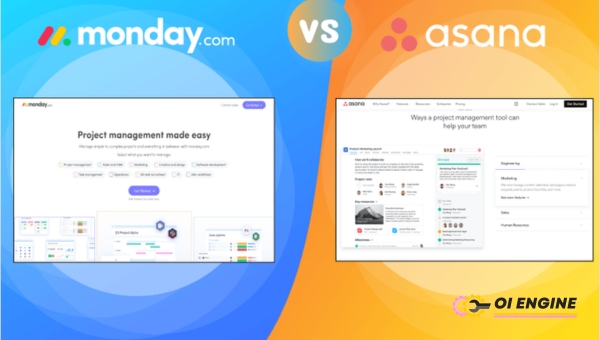In the tech-infused age I live in, project management tools form an essential part of effective planning and coordination. Among these tools, a spirited discourse often emerges when comparing Asana vs Monday.
These powerful platforms offer integrated environments with sophisticated features, and each has its charm. But how do they stack up head-to-head? This riveting question seems to be on everyone’s lips in the industry.
When it comes to choosing between Asana and Monday, it pivots on your specific needs. If you’re seeking a simplistic interface with a robust set of intelligent integrations, then Asana might be your go-to choice.
On the other hand, if flexibility and visual project workflow are high on your list of priorities then you’ll find your solution with Monday.com.
Understanding Asana and Monday
To get a better grasp on Asana Vs Monday, it is important we first understand what these tools are individually.
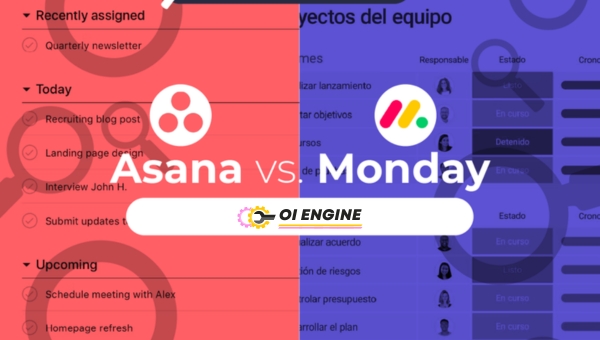
Both are leading project management software that helps to streamline tasks, improve team collaboration, and ultimately boost productivity.
What is Asana?
Asana, my go-to for task management, is an online platform designed to help teams organize their work and manage projects efficiently. From my personal experience, I’ve found it to be particularly useful when managing both small daily tasks and larger ongoing projects.
The hallmark of Asana lies in its ability to categorize tasks, assign them to different members of the team, set due dates, and follow up on progress.
Thus ensuring a smooth flow of work without any hiccups or backlogs. I appreciate the visual aspect where you can view your project in lists or boards similar to Trello but more comprehensive.
Moreover, Asana’s flexibility comes in handy when you need it most. It allows me to create unique workflows for different projects with features like subtasks for clearer division of labor and breaking down larger goals into manageable actions.
What is Monday?
If you’d ask me about Monday.com, think about an intuitive collaborative space online where teams can track their workflow with ease and absolute clarity. To me, it always stood out as one interactive platform that could be easily understood by everyone involved in the project.
On one side there’s easy access to a high-level overview of all current projects—basically what’s happening right now within your team—and on the other side keeping track of intricate details related to each task has been made pretty straightforward with Monday.
Notably, I’ve found its rich customization options quite useful which allows users to mold the tool according to their needs; therefore catering to a wide range of industries precisely justifies how versatile Monday.com is.
By being not just a project management tool but also a great solution for CRM, software development, and even HR operations surely puts it in the leading position.
Also Read: 8 Top Rated Non-Trucking Liability Insurance Providers
Comparing the User Interface of Asana vs Monday
When considering the Asana vs Monday debate, it’s essential to inspect their respective user interfaces. A well-designed UI not only enhances user experience but boosts productivity too.
Let’s delve into the ease of use and the navigational disparity between these two project management giants.
Utilization and Ease of Use in Asana
Asana stands out amongst its competitors when it comes to usability. It has a simplistic interface that any newcomer can adapt to with little guidance.
- Right from the first login, I appreciated how intuitive and uncomplicated Asana’s dashboard is. It employs a minimalist design with enough breathing space around all components.
- Navigating between tasks and projects is as simple as clicking on corresponding tabs on the sidebar. I found myself comfortably commuting across different project pages in no time.
- To further simplify things, creating new tasks or updating current ones is made convenient with an easy-to-access ‘Add Task’ button right on top. This significantly reduces the time for task assignments.
Overall, utilizing Asana is more like a ‘walk in the park’. Thanks to its clean layout coupled with efficient structuring of functions.
Navigating Through User Interface on Monday
On reflecting on my experience with Monday.com through an impartial lens, I can confidently say that it embraces user-friendliness at every turn of navigation.
- The initial setup requires some attention due to its vast array of features, once you get hold of it, things just flow smoothly.
- Each operation has been mapped out clearly; be it switching between boards or interacting within them. The toolbar located at the left allows quick shifting amongst different activities.
- One thing that fascinated me was their color-coded status updates – they visually summarize progress making tracking efficient and easy on eyes!
While facing off Monday vs Asana based solely upon interface navigation could lead to a draw; particularly because both contender platforms mirror equal dedication towards user comfort, with very minor hiccups here and there, leaving the door wide open for personal choice.
Also Read: Safeguard With 8 Top Occupational Accident Insurance
Task Management in Asana vs Monday
To effectively manage a team, you need to juggle numerous tasks simultaneously. Efficient task management is vital for the success of any project.
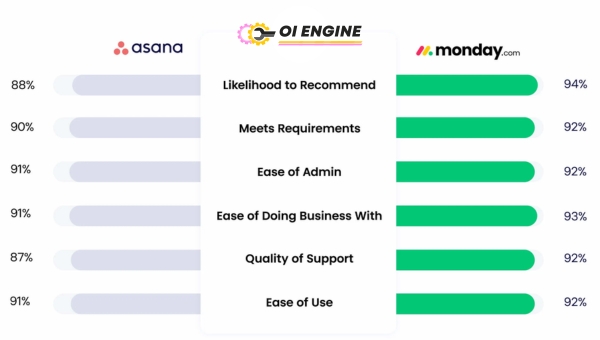
In this segment, I will compare how task assignment works in Asana and the efficiency of task management on Monday.com.
How Does Task Assignment Work in Asana?
Task assignment in Asana is refreshingly straightforward. Here is a simple breakdown of how it works:
- Task Creation: In just a few clicks, I can create a new task. I simply type the name of my new task into the “Add task” area and hit enter. It’s as easy as entering text into my phone.
- Task Assignment: The next logical step is assigning that task to a particular person on my team. Again, no complex procedures are involved here – all I have to do is select the assignee from a dropdown list.
- Tracking Tasks: To keep an eye on progress, I often turn to Asana’s status updates feature which allows me to quickly see whether tasks are moving along smoothly or hitting snags revealing where more attention may be needed.
- Completion Features: Finally, once completed tasks can be checked off directly within each project’s dashboard providing instant visual confirmation of your project’s progression.
What impresses me about Asana is its intuitive approach – it does take convenience and simplicity very seriously.
The Efficiency of Task Management on Monday
When it comes to handling tasks efficiently, Monday.com also dishes up some strong moves:
- Creating Tasks: Just like with Asana, I enter my new task into an input box labeled “New Item,” then hit the return key, and boom! My new item lands right on my workflow.
- Assigning Tasks: Assigning that newly created job involves selecting assignees from members added already or simply adding more members according to need.
- Tracking: Regular updates on task status keep me in the loop as a project advances. Just a glance at the columns color-coded according to status, gives me an instant picture of where each task stands.
- Completion: Monitoring the completion of tasks is clear-cut too. Once a task hits its end, it can be moved to the ‘done’ column providing an instant visual snapshot of overall project development.
Both Asana and Monday.com score well in terms of providing sleek, easy-to-run, and efficient task management solutions. These platforms have truly revolutionized my ability to handle different assignments without overwhelming myself – or anyone else on my team!
PM Workflow Comparison – Asana vs Monday
When considering project management tools like Asana and Monday, workflow design becomes a critical factor.
Simplistic yet powerful workflows mean tasks get managed better, progress gets tracked more efficiently, and ultimate goals are achieved faster. Let’s delve into the specificities of the two in comparison.
Workflow Design in Asana
As I ruminate on my experience with Asana, I recall several impressive features that make it excel in workflow management:
- Visual Project Timelines: This has been crucial for me when trying to visualize a project’s progress over time. Thanks to this feature, at a glance, I can tell how much ground we’ve covered and what lies ahead.
- Project Sections and Columns: Organization is key in any project. With this feature, I’ve managed to keep tasks neatly categorized which makes the whole process more manageable.
- Automated Workflows: With this function at my disposal, recurring tasks got automated leaving me with more time for other pressing issues.
- Integration with Other Tools: The smile on my face when I discovered that Asana integrates well with several of my most used apps like Slack or Google Calendar- invaluable!
Looking into Workflow Options with Monday
Now onto monday.com! In playing around with its offerings:
- High Customization Level: The customizability is significant here; it allowed me to tailor our workflows exactly as per our needs- highly appreciated!
- Centralized Communication: No need to switch between Monday and your email or chat app anymore – you can keep all discussions right there within tasks.
- Shareable Boards: This one came as a delightful surprise! Sharing boards allowed everyone involved to better understand their role within the project scope.
- Time Tracking Accessory Adding time tracking capabilities was a brilliant feature- being able to directly track how much time each task takes helped quite a bit in future planning.
Evaluating both, I realized it’s the extensive yet user-friendly workflow options of each that make them so sought after in their own right.
Also Read: Pilot Car Insurance – Top Companies Revealed!
Significant Integrations for Enhancing Efficiency: Asana Vs Monday
When it comes to project management, I believe that the ability to integrate with other software significantly enhances a tool’s efficiency.
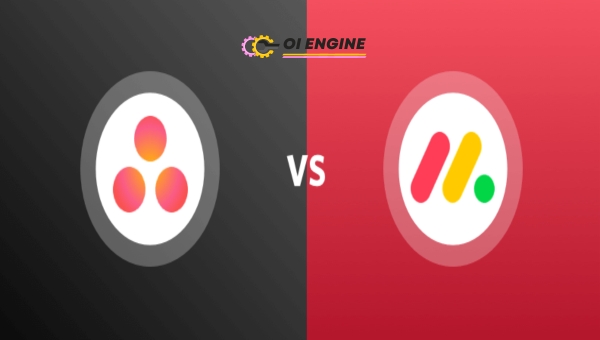
It saves me from switching between different applications and streamlining my workflows in a unified platform. Therefore, I have taken up an evaluation of the integration capabilities available within Asana and Monday.
Integration Capabilities with External Tools within Asiana
As an avid user of Asana, I find its compatibility with numerous key business tools incredibly helpful. Below are some of its primary external integrations:
- Google Drive: This integration allows me to attach files directly from Google Drive into tasks.
- Slack: Slack is great for communication in my team, and through this integration, I can convert conversations into actionable tasks on Asana.
- Microsoft Teams: With this pairing, I get updates about my Asana tasks right within Microsoft Teams which promotes quick task reviews.
- Zapier: Zapier is like the glue that connects different software. The possibilities become endless when you connect it with Asana as you can create triggers for nearly any scenario you can think of.
I feel that these integrations give a huge boost to my productivity by ensuring everything stays in one place without compromising on data visibility or accessibility.
Blend with Third-Party Applications of Monday
On the other hand, Monday.com’s blend with various third-party applications is also nothing short of impressive. Here are some examples:
- Excel: Many businesses still heavily rely on Excel for their data analysis needs. By integrating it with Monday.com, users get advanced spreadsheet functionalities while maintaining real-time collaboration.
- Gmail & Outlook:
With email integrations like Gmail and Outlook corralled into Monday’s platform, managing communications about your projects becomes a breeze regardless if they come from internal or external stakeholders. - Zoom: As remote work becomes the norm, the relevance of tools like Zoom cannot be emphasized enough. Monday’s integration with Zoom enables you to schedule and join meetings right from your tasks or workflows.
- Jira: Jira has become indispensable for software development teams. With this integration, tracking progress between your development and non-development teams can all happen within Monday.com.
In my opinion, by showcasing an effective blend with vital third-party applications, Monday.com goes a long way in aiding teams to keep their conversations and collaborations consolidated in one place.
Customer Service Analysis of Asana and Monday
As a busy professional, I rely heavily on high-quality customer service from the project management tools I use.
Timely help and support when facing technical issues are crucial. Thus, it’s worth comparing the customer service provisions of Asana vs Monday.
Asana
In my experience with using these platforms, here’s what I have found out about Asana’s customer service:
- Help Center: Accessible within the platform, it has multiple articles and guides to help users navigate through the platform or troubleshoot issues.
- Customer Support via Email: Valuable if you’re stuck with a technical issue or functional query. These queries are monitored by a team promptly responding to all such requests.
- Community Forums: Where users share their experiences, tricks, and tips for efficient performance.
- Interactive Tutorials: Onboarding new team members is simplified due to step-by-step tutorial guides that make learning straightforward.
- Fast Resolution Time: From my personal experience, almost every ticket or query is addressed rapidly – usually within 24 hours.
Monday
Equally useful in its way is Mondays’ customer service. Here are some points on that:
- 24/7 Customer Support – Immediate assistance around the clock regardless of your timezone can be genuinely advantageous when deadlines loom ahead!
- Extensive Knowledge Base – It houses useful articles covering virtually every feature offered by Monday.com.
- Webinars & Video Tutorials – These resources are beneficial for understanding how various features work in real-time scenarios.
- Online Community Forum – This space for user interaction lets peers discuss their knowledge about various practices and possible solutions.
- Direct Contact through Live Chat – This handy feature offers swift communication with support personnel for immediate answers or fixes.
In this head-to-head battle between Asana vs Monday in terms of customer service; both platforms excel and provide users with resources to address technical hitches or enhance their platform understanding. Thus, it boils down to individual needs and preferences.
Also Read: Unleashing Top 10 PEO Services For Smooth Sailing In 2024
Asana vs Monday Pricing
When looking at how much Asana and Monday cost, I see pretty big differences in their pricing plans. It’s clear both of them want to give options that fit different team sizes and needs.
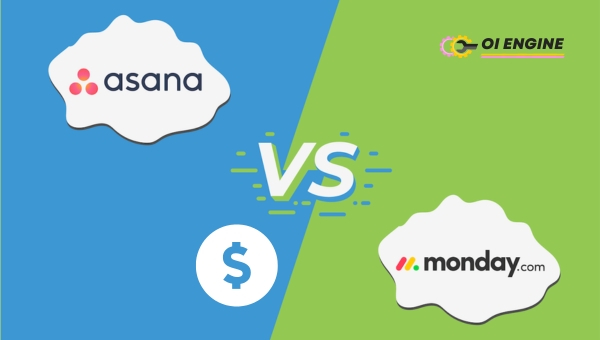
The cost can be a deal-maker or breaker if you’re running on a tight budget or you have specific needs for your projects.
Asana
When I dig into the pricing for Asana, these points stand out:
- Free Basic Plan: This is great if you’ve got up to 15 people working together. You won’t have to pay anything.
- Paid Plans: If your team needs more features, like better ways to view projects or automate some steps, Asana has paid options.
- Advanced: For about $13.49 per person each month
- Business: Around $30.49 per person per month, this one’s got deeper reporting and help options.
- With these paid levels, you get more than just the basics – like ways to see your work differently that could make things clearer when it gets complex.
Monday
Now let’s look at what Monday.com offers:
- Free Individual Plan: Good for two people wanting basic tools without spending money.
- Minimum Block of 5 Users: Their paid plans don’t start at just one person; they start at five. So even if you’re alone but want those extra features? You’ll be paying for five spots.
- Basic: Starts at $8 monthly for every user.
- Standard: The next tier up is $10 a month per user with features tooling visual work in cool ways and making some tasks automatic.
- The higher levels like Pro and the business scale option called Enterprise have even more tools but cost more too – Pro is around $16 monthly for each person using it.
Each service stacks up unique benefits in their pricing plans – whether it’s how many people can use them for free or what kind of powerful extras they include once you start paying.
FAQs
Is Monday better than Asana?
It depends on what you need. Monday offers a very visual way of managing tasks, which some find better. Asana is often chosen for its simplicity and focus on task management.
Which is better, Notion or Asana?
The notion is more flexible and acts like a workspace with notes and documents, while Asana is a dedicated task management tool. Choosing between them depends on whether you prefer a broad tool or one specifically for tasks.
Is Asana cheaper than Monday?
Yes, generally speaking, Asana can be cheaper than Monday. Especially because it provides free access for up to 15 users, whereas Monday’s free plan covers only 2 users.
Do big companies use Asana?
Yes, many large companies use Asana to manage their projects and improve team collaboration.
Why is Asana so popular?
Asana’s popularity comes from its user-friendly interface, easy-to-learn features, and effective task management capabilities.
Also Read: Top 14 Truck Factoring Companies 2024
Conclusion
In the battle of Asana vs Monday, both platforms show convincing strengths. However, considering the specific needs of your project or organization could tilt the balance.
If you want unlimited tasks and prefer free access for a smaller team (up to 15 members), Asana has an edge here. But if your preference leans towards a highly visual interface with robust automation features and hassle-free navigation, Monday.com seems more appealing.
It’s crucial to focus on what best meets individual business workflows, integrates well with obligatory external tools, offers excellent customer support, and fits your budget just right. No tool is inherently better than others—it all boils down to what you need.
